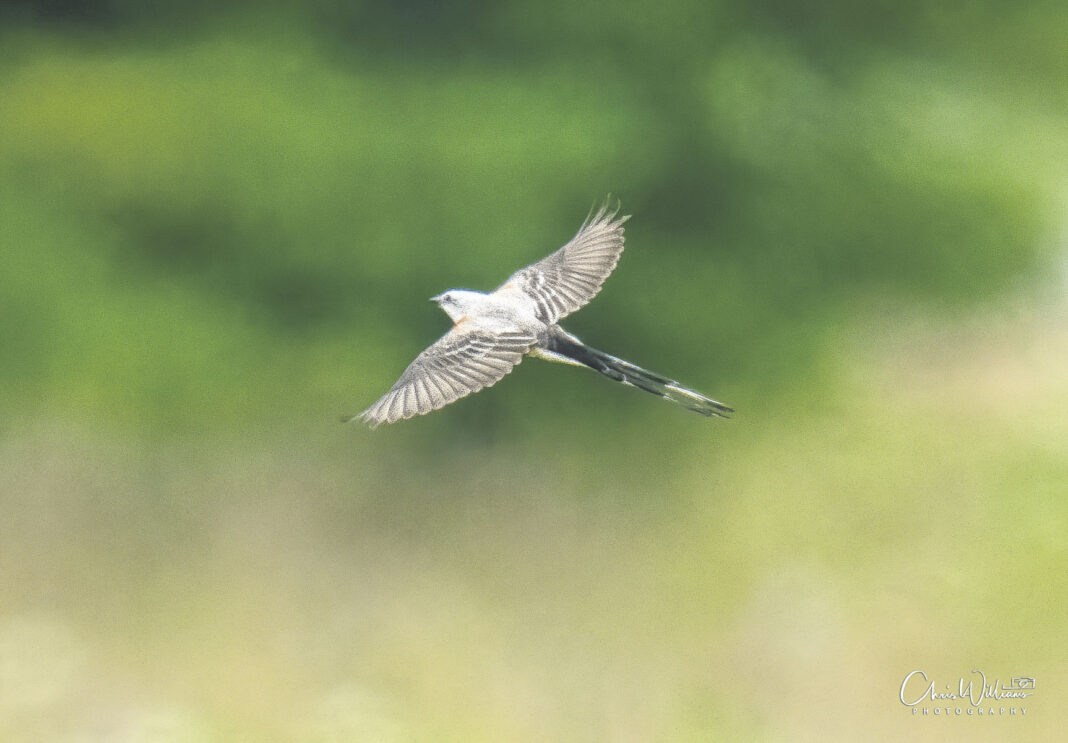By Taylor Wooten
Hundreds of bird enthusiasts are flocking to Johnson County Park to get a glimpse of a nesting bird native to Texas and rarely seen in Indiana.
The scissor-tailed flycatcher, also known as the Texas bird-of-paradise, has recently made a tree near Camp Atterbury its home, and area birders, scientists and even National Geographic are taking note.
Scissor-tailed flycatchers often spend winters in Mexico, Central America and South America, making southern U.S. states preferable the rest of the year, according to AllAboutBirds.org.
The bird is usually only spotted in Indiana about once every five years, said Brad Bumgardner, a spokesperson for the Indiana Audubon Society.
What’s more significant about the bird sighting is that she is nesting with her eggs. In previous sightings of the bird in the Midwest, it has been a “one day wonder,” or a one-day sighting, Bumgardner said.
The extended stay of the nesting female bird has bird watchers spending their days trying to sneak a peek.
The nest also gives bird enthusiasts a slight hope for a second, male scissor-tailed flycatcher that would have mated with the bird. Soon, the eggs will hatch and create a family of them at Johnson County Park. The odds of this happening are slim, though, Bumgardner said.
Instead, it is more likely the bird mated with an eastern kingbird. The scissor-tailed flycatcher commonly mates with eastern kingbirds, which are plentiful in the area, local bird experts say.
Mike Clay, a Johnson County birder who assists in the county’s biannual bird counts, said it’s unusual for the male to not be near the nest.
“The behavior is such that we don’t know why the male is not sticking around,” Clay said. “So it may just be that something happened.”
Many bird enthusiasts keep lists of birds they have seen. To see a scissor-tailed flycatcher, those interested would normally have to travel to Arkansas, Oklahoma or Texas, Clay said. Instead, birders throughout the Midwest have traveled to Central Indiana to add the bird to their lists.
But, the large amount of birders at Johnson County Park can cause problems for the nesting bird. Some individuals have been approaching the nest too closely, causing the mother bird to become stressed, Clay said.
“We don’t want to stress this bird anymore,” he said. “She’s already stressed because it’s already going to be hard for the bird to feed the babies.”
To prevent this, individuals should invest in binoculars to see the bird more closely. This isn’t necessary to see the bird though, because the scissor-tailed flycatcher has a distinct, long tail, Clay said.
For people wanting to become more involved in birding, they can become part of the county’s biannual bird count. Birds only need to be within a 7-mile radius of Johnson County Park and the counts take place in May and December.
Participating in the bird count can be done from one’s backyard or by traveling to a nearby park or field, Clay said.
Birders often start off with their backyard birdfeeders, and it escalates to driving to a local park, then driving 20 miles away to see new birds, he said.
“It ranges all the way from that, to people that will drive hundreds of miles or maybe even fly across the country to see birds,” Clay said.
Johnson County Park has 242 recorded species of birds. Megan Bowman, park superintendent, has done a good job of planting trees and prairie grasses that cater to the expansive bird population and prevent invasive birds, he said.
“To have birds, you have to have habitat,” Clay said.
Scissor-tailed flycatchers have an estimated global breeding population of about 9.5 million, with 92% breeding in the United States, according to Partners in Flight.





